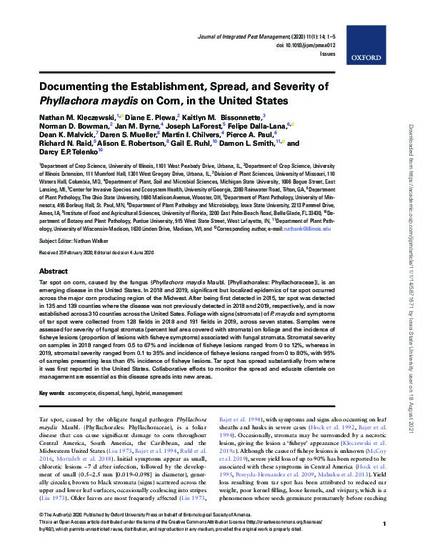
Tar spot on corn, caused by the fungus (Phyllachora maydis Maubl. [Phyllachorales: Phyllachoraceae]), is an emerging disease in the United States. In 2018 and 2019, significant but localized epidemics of tar spot occurred across the major corn producing region of the Midwest. After being first detected in 2015, tar spot was detected in 135 and 139 counties where the disease was not previously detected in 2018 and 2019, respectively, and is now established across 310 counties across the United Sates. Foliage with signs (stromata) of P. maydis and symptoms of tar spot were collected from 128 fields in 2018 and 191 fields in 2019, across seven states. Samples were assessed for severity of fungal stromata (percent leaf area covered with stromata) on foliage and the incidence of fisheye lesions (proportion of lesions with fisheye symptoms) associated with fungal stromata. Stromatal severity on samples in 2018 ranged from 0.5 to 67% and incidence of fisheye lesions ranged from 0 to 12%, whereas in 2019, stromatal severity ranged from 0.1 to 35% and incidence of fisheye lesions ranged from 0 to 80%, with 95% of samples presenting less than 6% incidence of fisheye lesions. Tar spot has spread substantially from where it was first reported in the United States. Collaborative efforts to monitor the spread and educate clientele on management are essential as this disease spreads into new areas.
Available at: http://works.bepress.com/alison-robertson/293/

This article is published as Kleczewski, Nathan M., Diane E. Plewa, Kaitlyn M. Bissonnette, Norman D. Bowman, Jan M. Byrne, Joseph LaForest, Felipe Dalla-Lana et al. "Documenting the establishment, spread, and severity of Phyllachora maydis on corn, in the United States." Journal of Integrated Pest Management 11, no. 1 (2020): 14. doi:10.1093/jipm/pmaa012.